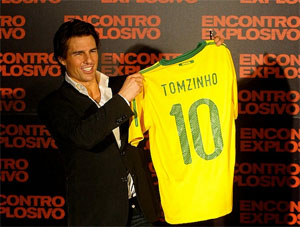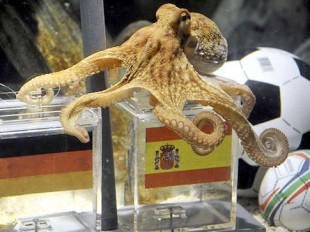The nation of Germany is in shock as Paul, the “oracle octopus,” has picked Spain to win over Germany in today’s World Cup semifinal. Thus far Paul has accurately predicted the results of all five of Germany’s World Cup matches, including the loss to Serbia. Beginning with Euro 2008, the cephalopod has a record of 9-1, his only previous prediction gone bad being that Germany would beat Spain in the Euro 2008 final. Oliver Walenciak, Paul’s keeper, says that the octopus is unfazed by recent death threats. “There are always people who want to eat our octopus but he is not shy and we are here to protect him as well. He will survive.”
Meanwhile, controversy is brewing in the German camp over World Cup captain Philip Lahm’s comments that he has no intention of relinquishing the armband to Michael Ballack when Ballack recovers from his ankle injury.

Toolzinho: At the premier of his new movie - called "Explosive Encounter" in the Brazilian market (which sounds like something that happens to me after too many beers and bean burritos) - in Rio, Tom Cruise shows off the brand new shirt that he will never wear.
Jozy Altidore went to a Mets game on Monday and talked to reporters about the fact that no US striker has scored a goal in the last two World Cups, his disappointment at losing to Ghana, Bob Bradley’s future, and his own at Villareal. “There are a lot of things I can improve on. I’m not even close to a finished product.”
SI’s Steve Davis looks at Bob Bradley’s future as coach of the national team which, given that his contract expires in December, is not likely to be much longer. Lurking in the background is the guy US soccer wanted in the first place: Jürgen Klinsmann, who gets an in depth look in this San Diego Union-Tribune piece that argues the current success of the German team can be traced directly to Klinsmann’s stint as head coach. For a recap of what Klinsmann has had to say recently about US soccer, look at this earlier piece by Davis.
Self-admitted soccer critic Jay Mariotti of Fanhouse.com has a very thoughtful piece on Landon Donovan and the burden of his task: sell soccer in the US long-term.
The data is in from NASA: much like funding for manned space missions, the Jabulani ball is “erratic and unpredictable.” Thank goodness for NASA scientists.

Maradona's already got a statue - that's it in the doorway to the left in this shop outside of Estadio Alberto J. Armando, Boca Juniors stadium in Buenos Aires. Photo courtesy of Richard Caswell.
An Argentinian lawmaker has proposed erecting a statue of Maradona in honor of his status “as an icon of popular Argentine culture.” Whether Maradona will stay on as coach of Argentina is reportedly up to him but everyone from the president of the country to an assistant coach and players on the national team are encouraging him to do so.
Everybody has their favorite soccer bar. Here’s a look at one in Chicago and what it means to its owner and the soccer community in that city.
Yahoo! Sports is reporting that “according to multiple sources,” AC Milan is interested in Clint Dempsey. Speaking of Americans at AC Milan, Oguchi Onyewu is busy refusing loan offers as he hopes to establish himself on the Serie A team.
Two Italian soccer fans were shot in a bar in Hannover, Germany and later died after getting into an argument with a German soccer fan about their countries respective histories at the World Cup.
Barcelona is forced to seek a €150m loan in order to pay wages owed to coaching staff and players.
Chelsea are preparing “what is likely to be a record British transfer fee” bid for Fernando Torres.
Why I wish I was still in college: Rutgers-Newark is offering a summer course on the global history of soccer.


?Crafting the Critical Analysis
A critical analysis (usually called a critique, critical summary, or book assessment) can be described as systematic analysis of an idea, textual content, or piece of literature that discusses its validity and evaluates its worth. A critical analysis usually involves a summary-a concise restatement of what a textual content says-and an evaluation-how properly it says it. A critical analysis in literature, for example, might possibly examine the style, tone, or rhetorical appeals of the textual content, as an analysis of the scientific paper may perhaps examine the methodology, accuracy, and relevance belonging to the research.
A very good critique will consider the following questions
Who is the author, and what are his/her qualifications?
What is the nature belonging to the show results (type, purpose, intended audience)?
What is its significance? How does it compare to other material in the same subject? By the same author?
What is the author’s thesis?
What is the organizational plan or method? Is it nicely conceived? Does it get the author’s objectives?
What are the underlying assumptions? Are they stated or do they lurk behind a stance of neutrality and objectivity?
How do assumptions and biases affect the validity from the piece?
Are arguments/statements supported by evidence? Is the evidence relevant? Sufficient?
Is the author’s methodology sound?
What evidence or ideas has the author failed to consider?
Are the author’s judgments and conclusions valid?
What rhetorical strategies does the author use? Are they effective?
A word about the thesis statement
Remember that no matter what format you follow in crafting your critical analysis, it should have a thesis statement that establishes your procedure to or opinion about the piece. Your thesis statement will not be the same given that the original author’s thesis statement. For example, say that the original author’s thesis statement is “the moon is made of green cheese.” Your very own thesis could very well be “the author’s assertion that the moon is made of green cheese is ill-founded and isn’t supported with adequate evidence.”
Organizing the Critical Analysis
There are nearly all models for crafting a critical analysis. Some disciplines recommend breaking an analysis into two sections: The first of all section allows for a summary within the content on the deliver the results, as the second section analyzes and evaluates the do the trick. Other disciplines, in contrast, favor a design in which the summary and analysis are smoothly integrated. See the reverse side for two serviceable (if unembellished) formats for a critical analysis. Also, remember that size can vary from the paragraph to several webpages.
Sample Critical Analysis – Two-Part Structure
Introduction
Section]
In “Nature Cannot be Fooled,” originally published in 1998 within the St. Louis Post-Dispatch, and source] Washington University Professor Jonathan Katzname and descriptor] contends verb] that American Society denies reality, living instead as if its “wished-for fictions” were being “true” (and partial quotation) of author’s thesis]. Katz further arguesverb] that this distorted look at of reality manifests itself in plenty of negative ways-from public health policy to education. of key ideas]
Section]
(Note that the evaluative terms are bold-faced with the purposes of illustration only.)
Unfortunately, Katz fails to assist his argument. His commentary relies onfallacies, unsupported promises, and opinions rather than on reasonable statements, supported promises, and facts. Therefore, even though Katz expresses substantially passion, he fails to offer a persuasive argument. your private thesis statement to offer you an organizational plan to the paper.]
Body Paragraphs
The body paragraphs should analyze particular factors from the function. For instance, in an analysis on the Katz commentary, the body would offer unique illustrations belonging to the flawed passages in Katz’s commentary; these illustrations would guidance the analytical statements that you simply are making about the succeed. The focus, then, is goal analysis, not subjective response.
Summary
The summary may restate the author’s thesis, but the main purpose within the summary should be to emphasize your assessment for the writer’s job.
Sample Critical Analysis – Integrated Design
1 technique for integrating a summary and an evaluation is simply to merge the two separate sections (like the examples previously mentioned) into an individual introductory paragraph. Another technique is to synthesize the summary and evaluative comments, as within the following sample introduction:
Introduction
In 1936, J.R.R. Tolkien wrote “Beowulf: The Monsters plus the Critics” for an audience of literary scholars of his personal working day. Thus, the essay can pose some difficulties for cutting-edge readers, who may not be familiar with literary history or the specified critics to whom Tolkien refers. Moreover, Tolkien’s diction is formal and pretty dense. Nevertheless, he has a persuasive and masterful defense of Beowulf, one particular of England’s most beloved is effective. thesis] Tolkien argues that Beowulf scholars are wrong to mine the poem solely for historic evidence about the Anglo-Saxon period, rather than reading it as a useful and inspiring get the job done of literature. s thesis] Although he agrees that its historical value is higher, he shows that Beowulf is so powerful as a poem that its literary qualities far outshine its historical value.
Teresa Sweeney & Fran Hooker Webster University Producing Center, 2005 essay writing services